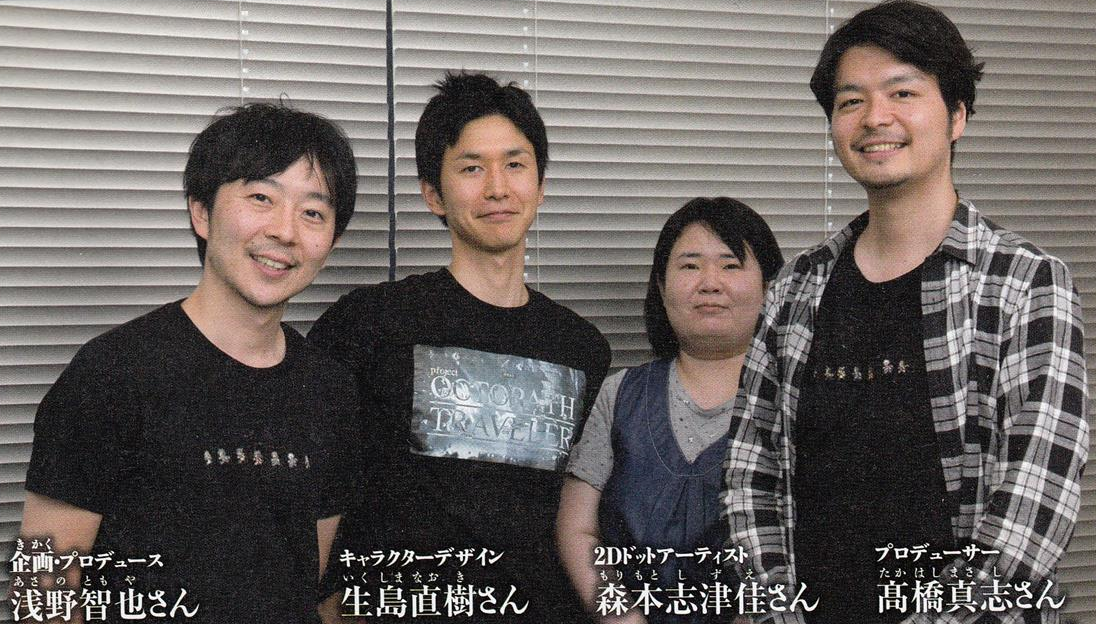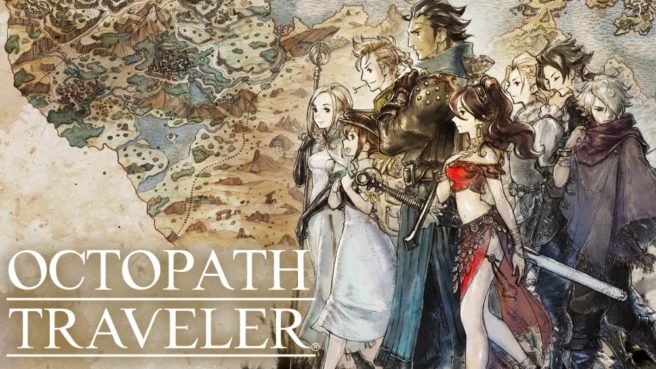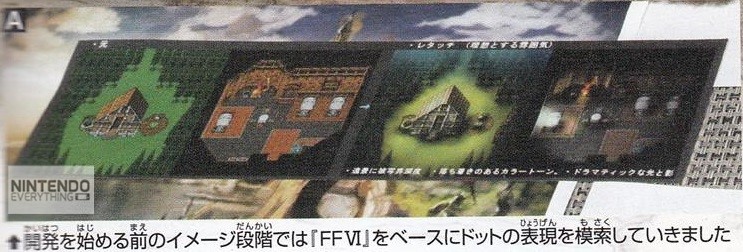Octopath Traveler devs on character origins, visual style, initial HD Rumble plans, much more
Posted on November 3, 2018 by Oni Dino(@Oni_Dino) in News, Switch
A recent issue of Nintendo Dream features an informative and lengthy interview with Octopath Traveler’s main producers from Square Enix, known as the “Asano Team”. The discussion focuses on art direction and learning more about the eight main characters (who were originally going to be a team of up to twelve!) with behind-the-scenes information on changes to characters’ designs, names, and personalities. We also have a brand new look at initial prototypes for the visual style, talk about a scrapped HD Rumble idea, and much more.
Check out our exclusive translation below to learn first-hand how Octopath Traveler started out based on Final Fantasy VI and Romancing SaGa 3, and how the team pioneered a new “HD-2D” art style to create a JRPG that feels nostalgic, yet brand new, all at once.
The following interview features the four key members of Square Enix’s “Asano Team” pictured below.

From left to right:
- Tomoya Asano – Chief producer, Planner
- Naoki Ikushima – Character Designer
- Shizuka Morimoto – 2D Pixel Artist
- Masashi Takahashi – Producer
Square Enix launched “Octopath Traveler” worldwide on the same release day. How was the reaction from international fans?
Takahashi: The reaction from our international fans has been overwhelmingly positive! This was the first game we’ve worked on that had a simultaneous worldwide launch. With “Bravely Default” and “Bravely Second” we launched the Japanese version first, then the international versions came much later. During development of “Octopath Traveler” however, we were determined to have the game launch in all regions at the same time. So, as I said, our international fans have been extremely enthusiastic, but we actually made this game with a Japanese audience in mind. Back when we first released the “Project Octopath Traveler Demo” on the Nintendo eShop, we received over 1.5 million downloads worldwide. We asked those players to respond with their thoughts on the game via a questionnaire and, despite the window of opportunity being relatively tight, we got 45,000 responses back! And of those, roughly 70 to 80% of them were from international fans!
Asano: We wanted to hear it straight from the horse’s mouth: what do core fans of Square Enix RPGs want? What are they excited about? We knew that if we took that invaluable information into consideration, we could craft an experience that would surely please both Japanese and international fans.
Let’s talk about the development process and the themes your team used.
Asano: Well, once we decided on the theme of eight main characters, it became our foundation moving forward. The title is fairly simplistic in that it just means “The Eight Travelers”. These aspects can be the hardest parts to figure out when you’re beginning development on a new game, in my opinion. When we produced “Bravely Default” for the Nintendo 3DS, we had some international fans say things like, “What the heck? This isn’t English.” (nervous laughter) We worked closely with our localization teams this time around, though. Since it was planned from the start that we were going to have a simultaneous launch in multiple territories, we kept these kinds of things in consideration throughout development in order to avoid any issues down the road. So, the title was a collaborative effort.
Takahashi: We worked on the game for approximately three years. It took a lot of trial and error during the early development stages before we wound up with the theme of eight main characters. We wanted to create a simple game concept that would make anyone think, “Oh, this looks cool!” But what is a concept that would make anyone think that? While brainstorming, we thought about the idea of choosing your main character and their story. And so the title of “Octopath Traveler” was conceived.
Your team, the Square Enix “Asano Team”, has given us games like “Final Fantasy: The 4 Heroes of Light” and the “Bravely” series. You always create something that’s as refreshingly new as it is nostalgic – what kind of RPG did your team want to make with “Octopath Traveler”?
Asano: We boiled it down to one main objective: design a game that the most loyal fans of Square Enix RPGs would want.
Takahashi: We intended for this game to be a spiritual successor to “Final Fantasy VI”, just as we had intended for the “Bravely” series to be a spiritual successor to “Final Fantasy V”.
Speaking of, there are 12 main characters in “Final Fantasy VI”, right?
Takahashi: That’s right. With “Octopath Traveler”, we wanted to go the same route and have our lead characters be part of an ensemble cast.
Asano: With this title, we wanted to evolve established concepts from the “Bravely” series, so while work-shopping our opportunities to do so, the word “ensemble cast” came up during early development.
Did your work during development on “Octopath Traveler” make you think of any other classic Square Enix RPGs?
Takahashi: Yeah, we knew that having a game with eight main characters might sound similar to the “Romancing SaGa” series, so we tried to differentiate this title by increasing the lead character count to nine… we even went to twelve at one point. In the end, though, it really made more sense from a balancing point of view to have eight characters. That way you can make two parties of four.
Asano: I also want to point out that “Octopath Traveler” does not have an open-ended story like the “SaGa” series. If I had to point out how these two titles have a different feel in that regard, I’d say it’s because in “Octopath Traveler” the player can enjoy a more focused story with each individual character.
This isn’t your average pixel art game – this is a new artistic expression you’ve dubbed as “HD-2D”. How did you come up with this exciting, new art style?
Asano: Well, firstly, the plan to make it a pixel game was in the works from the start.
Morimoto: This is the first image we made while we were still getting a feel for the style.
(Eagle-eyed fans will notice the original images are straight from Final Fantasy VI!)
Morimoto: At first, I started using some techniques to add dramatic lighting to the 2D art, but Asano told me that wasn’t enough. He wanted me to make something that a player would see and feel confident in spending full price on. So I thought, “How can I take this one step further?” Once I started incorporating some 3D elements, it really gave the visuals a sense of depth.
Asano: I wanted to make use of lighting mixed with pixels in a way that emphasized how light shines on objects and how shadows fall.
And I assume battles were the same, too?
Asano: Well, we weren’t sure how much of this new style we wanted to use and how much of the traditional side angle from “Final Fantasy” that we wanted to use. We went through many iterations trying to find the right look.
Takahashi: We knew that if we just made a pixel game, it wouldn’t feel like the visuals had progressed enough for modern times. From a visual standpoint, when you compare what games were like way back then with what games are like now, the pixel count and image resolution has increased by an overwhelming degree. So you have to think about how detailed you want to go; if you go too far down the rabbit hole, then it just turns into a pretty picture. With that said, if you just make your pixels thicker then all you’re doing is creating the same look as back then, and you’re just overcompensating for nostalgia’s sake. Though the quality of the image ends up about the same, I think it ends up looking worse somehow. We really had a lot of challenges with these specific aspects. So, ultimately, we left in a good amount of pixel aesthetic and compounded that with a three-dimensional environment, and we created this incredibly lush visual style that we call “HD-2D”.
Asano: Compared to this image, we had visuals that were even more pixelated for a brief time. The turning point for us, though, was when we debuted “Octopath Traveler” with a trailer at the Nintendo Switch Presentation in January 2017.

